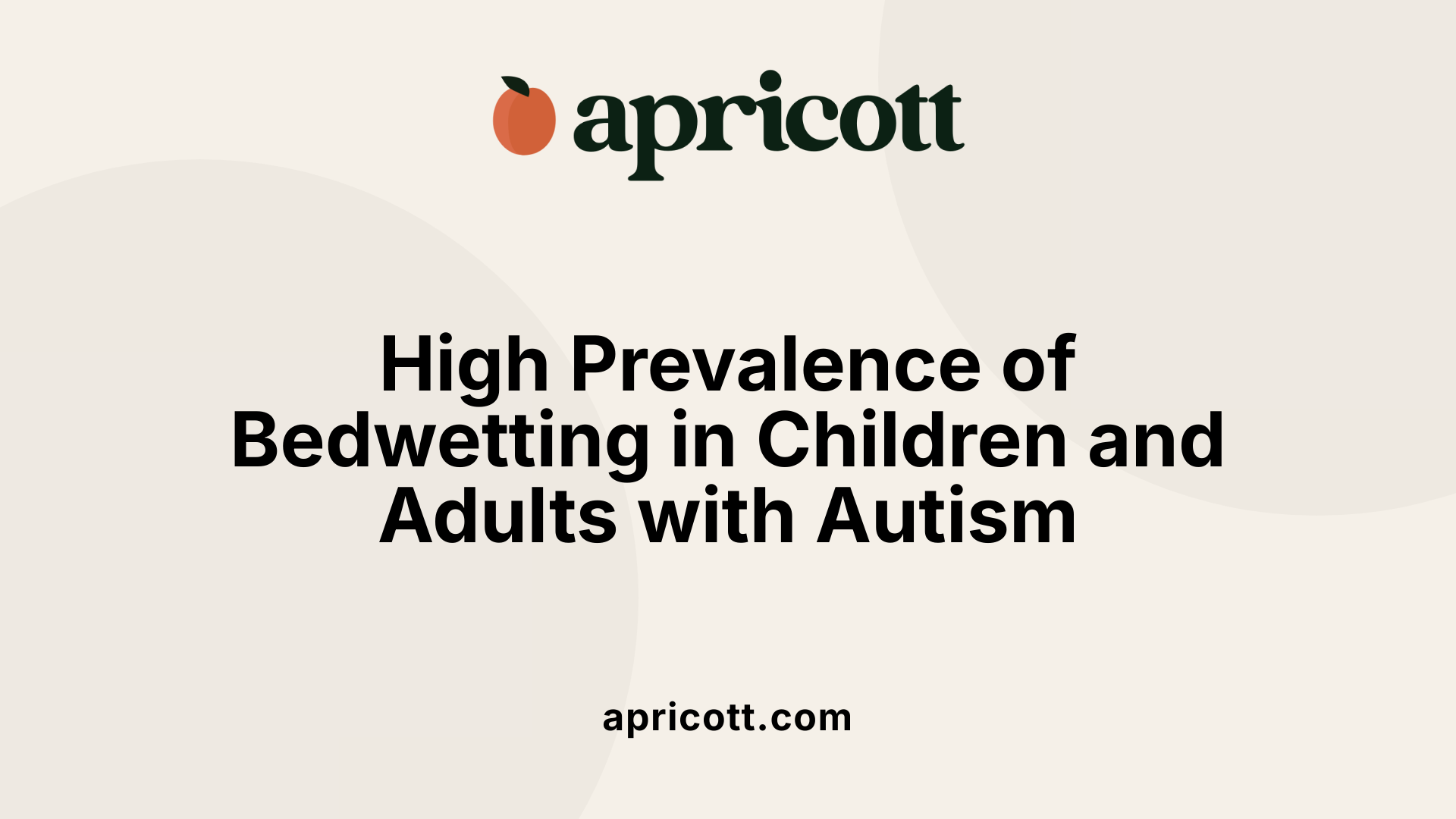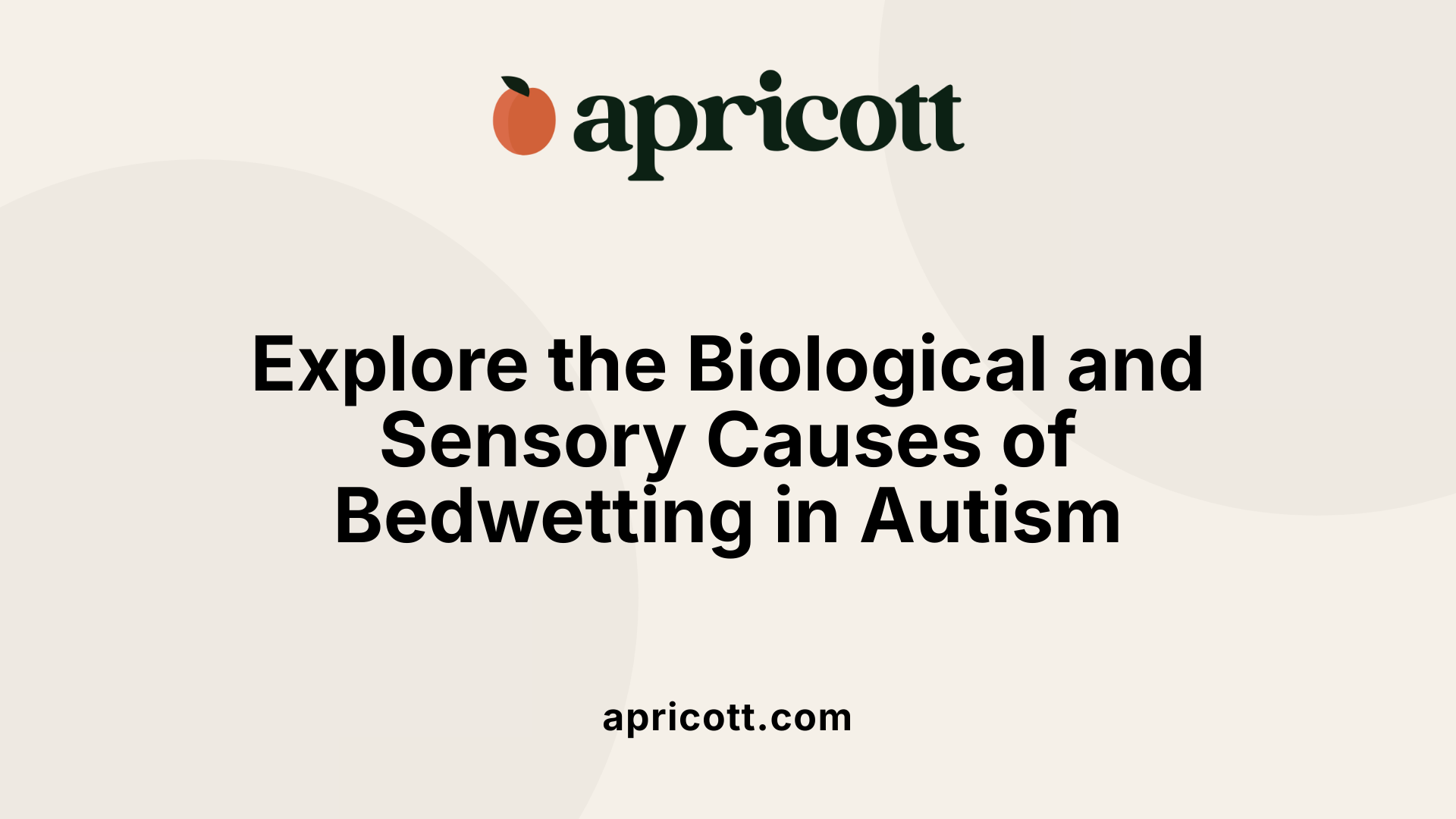An In-Depth Look at Bedwetting Challenges in Autism Spectrum Disorder
Bedwetting, or nocturnal enuresis, is a common issue that affects many children and adults with autism spectrum disorder (ASD). While often seen as a typical developmental phase in neurotypical children, bedwetting in individuals with autism can be influenced by unique sensory, developmental, and behavioral factors. This article explores the prevalence, causes, impacts, and management strategies associated with bedwetting in the autistic community, providing valuable insights for families, caregivers, and healthcare professionals.
Prevalence and Significance of Bedwetting in Autism

How common is bedwetting among individuals with autism?
Bedwetting, or nocturnal enuresis, is significantly more prevalent in children and adults with autism than in neurotypical populations. Research indicates that about 25% to 30% of children with autism experience bedwetting episodes, which is notably higher than the approximately 11% prevalence seen in typically developing children aged 10 to 14.
This increased rate reflects various underlying factors related to autism. Children with autism often face developmental delays in bladder control, which can extend the typical age for achieving night-time dryness. Sensory processing issues and communication difficulties may also hinder awareness of bladder fullness or the ability to respond appropriately during sleep.
Moreover, emotional factors such as anxiety or heightened stress, common among children with autism, can worsen sleep disturbances and contribute to bedwetting. Sleep disorders like sleep apnea and restless sleep patterns further reduce the likelihood of waking when the bladder is full.
Studies also reveal that autism co-occurs frequently with ADHD, another condition associated with higher rates of enuresis. Overall, the prevalence of bedwetting in this group is considerably higher than in neurotypical peers, highlighting the importance of tailored assessments and interventions.
While exact statistcs may vary, it is clear that bedwetting is a common concern among individuals with autism, impacting their daily life and emotional health.
Additional Insights
This greater rate of bedwetting can persist into adulthood. Over 80% of adults with autism report experiencing some form of bladder or bowel dysfunction, including types such as overflow or functional incontinence, which can be associated with ongoing sensory sensitivities and other comorbidities.
Recognizing the high prevalence helps inform families, caregivers, and healthcare providers to better support individuals with autism through appropriate medical, behavioral, and environmental interventions.
For more detailed statistical data and ongoing research, searching “Prevalence of bedwetting in children and adults with autism” can provide current findings and resources.
Causes and Contributing Factors of Bedwetting in Autism

What are the causes of bedwetting in children and adults with autism?
Bedwetting, or nocturnal enuresis, in individuals with autism results from a complex interplay of biological, sensory, and behavioral factors. One significant aspect is sensory processing differences. Many autistic individuals experience heightened or diminished sensory awareness, which can impair their ability to recognize bladder signals or internal cues that indicate the need to urinate.
Communication challenges further complicate the situation. Difficulty in expressing discomfort or the urgency of needs often means that children and adults with autism may not alert others or themselves when they need to go, leading to episodes of bedwetting.
Gastrointestinal issues, such as constipation, are also common in autism and can lead to overflow incontinence, where stool buildup exerts pressure on the bladder, causing involuntary urine leakage. This physical issue can be accompanied by a delayed development of bladder and bowel control, particularly in young children, prolonging the period of incontinence.
Sleep disturbances frequently observed in autism, including deep sleep and sleep apnea, play a major role. These conditions can impair the arousal response—the ability to wake up when the bladder is full—making it harder for individuals to recognize or respond to the urge to urinate during the night.
Genetic and neurobiological factors contribute as well. These may involve differences in brain regions responsible for bladder control and internal awareness. Co-occurring conditions like ADHD can increase the likelihood of bedwetting due to difficulties with impulse control and attention regulation.
Behavioral stressors, routine disruptions, and heightened anxiety can also exacerbate bedwetting episodes. Managing this condition often requires a broad, tailored approach that considers sensory sensitivities, developmental delays, sleep patterns, and medical health.
Overall, understanding these diverse causes helps in creating effective interventions and support strategies for autistic individuals experiencing bedwetting.
Impact of Bedwetting on Individuals and Families

What is the impact of bedwetting on individuals with autism and their families?
Bedwetting can significantly affect the emotional well-being of children with autism. Many experience feelings of embarrassment and shame, which can lead to lowered self-esteem. Such emotional challenges may impact their social interactions and willingness to participate in daily activities.
For families, managing their child's bedwetting often increases stress and anxiety. Parents may feel helpless or worried about their child's self-esteem and future development. The challenges are compounded by sleep disturbances common in children with ASD, such as parasomnias, scary dreams, or restless sleep. These sleep issues can worsen behavioral problems, adding another layer of difficulty for both children and their caregivers.
Associated issues like constipation and sleep problems can contribute to bedwetting's persistence. Although autism itself isn't a direct cause of bedwetting, these related factors can make it more likely to occur. Fortunately, thorough assessments by healthcare professionals and tailored interventions—ranging from sleep hygiene practices to medical treatment—can help manage bedwetting. Addressing these factors can improve the child's emotional health and lessen the worries faced by families.
Managing and Supporting Bedwetting in Autism

What strategies and management approaches can help with bedwetting in individuals with autism?
Handling bedwetting in children with autism requires a compassionate, multifaceted approach. Behavioral interventions are central, including the use of visual schedules, social stories, and reinforcement techniques that are tailored to the child's unique sensory needs and communication style. These strategies help children understand expectations and develop better bladder control over time.
One effective tool is the use of bedwetting alarms, which alert children when they begin to urinate, promoting awareness and potentially reducing incidents over time. Coupled with practicing good sleep hygiene—such as reducing screen time before bed, establishing a consistent bedtime routine, and creating a calming, sensory-friendly sleep environment—these methods can improve sleep quality and decrease bedwetting episodes.
Addressing underlying medical and sleep issues is equally important. Conditions like sleep apnea, night terrors, or constipation can exacerbate bedwetting, so medical assessments by pediatricians, urologists, or sleep specialists are often recommended. Managing medical conditions may involve medications or behavioral therapies, aiming to identify and treat contributing factors.
Environmental adaptations and sensory considerations play a crucial role. For example, ensuring the bathroom environment is comfortable, accessible, and sensory-friendly can encourage independence and reduce anxiety related to toileting.
Collaboration with healthcare professionals is essential for designing an individualized treatment plan. They can recommend pharmacotherapies when appropriate and guide parents and caregivers on implementing effective strategies.
Resources from organizations like the Autism Society and clinical guidelines from health authorities offer valuable support. Patience and understanding from caregivers are vital, as progress may take time, and punishment should be avoided.
In summary, managing bedwetting in children with autism involves a combination of behavioral strategies, medical evaluation, environmental adjustments, and professional support to promote comfort, awareness, and independence.
| Strategy | Description | Additional Notes |
|---|---|---|
| Behavioral interventions | Visual schedules, reinforcement, social stories | Tailor to child's communication and sensory needs |
| Bedwetting alarms | Devices that alert when urination starts | Promote awareness and response |
| Sleep hygiene | routines, reducing screens, sensory-friendly environment | Enhances sleep quality |
| Medical assessment | Evaluation of underlying health issues, treatment when necessary | Includes addressing constipation, sleep issues |
| Environmental adaptations | Sensory-friendly bathroom modifications | Encourage independence and reduce anxiety |
| Healthcare collaboration | Working with professionals for personalized plans | Consider medication, therapy options |
Implementing these strategies with patience and support can significantly improve the quality of life for children with autism experiencing bedwetting, while also reducing family stress and promoting confidence.
Resources and Support for Autism-Related Bedwetting
Are there educational or informational resources regarding bedwetting associated with autism?
Yes, multiple organizations provide valuable educational resources to help families understand and manage bedwetting in children with autism. The National Autistic Society and the Autism Society of America, for example, offer comprehensive guides, leaflets, and online courses specifically focused on toileting and continence challenges faced by autistic children.
These resources often include strategies tailored to address behavioral and sensory sensitivities that contribute to bedwetting, such as difficulty with bladder control, sleep disturbances, and heightened sensory sensitivities. Materials like Fleming & MacAlister’s book provide detailed insights into behavioral management techniques, while the ERIC (Educational Resources Information Center) website offers research-based strategies and articles.
Support brands like Goodnites have collaborated with autism organizations to develop products and educational tools that cater to children with special needs. These collaborations help families access specially designed incontinence products and educational content tailored to their child’s unique challenges.
In addition to community and product resources, healthcare professionals such as pediatricians, urologists, and pediatric psychologists can offer personalized assessments and interventions to identify and treat underlying medical or behavioral causes of bedwetting. These professionals are an essential part of a comprehensive support system for families navigating bedwetting in children with autism.
Supporting Autistic Individuals and Their Families
Understanding the complex factors underlying bedwetting in autism and employing tailored management strategies can significantly improve quality of life for individuals and their families. Through education, professional support, and compassionate care, it is possible to address the physical and emotional challenges of bedwetting, fostering greater independence and well-being within the autistic community.
References
- Let's Talk About Autism and Bedwetting
- ADHD, Autism, and Bedwetting: What You Need To Know
- Managing bedwetting in neurodivergent children
- Incontinence in children with autism spectrum disorder
- How to Manage Autism and Incontinence in Adults
- Managing bedwetting in neurodivergent children
- Let's Talk About Autism and Bedwetting
.svg)
.svg)








